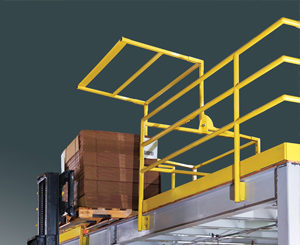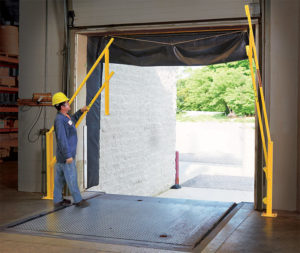
Your distribution center, like all warehouse-type facilities, is full of potential fall hazards. As the facility manager, it’s up to you to identify and correct these fall hazards to ensure that your workers are safe at all times. Equally important is making sure your people understand how to identify potential hazards and that they follow strict safety procedures. Otherwise, you risk worker injuries, high employee turnover, low productivity, legal issues, OSHA fines, worse a fatal injury.
Ensuring your distribution center is a safe workplace has to be everyone’s main priority from top management right down to the newest employee. In addition to providing workers with safety education, you need to make sure that you have adequate guardrails, loading dock safety gates, and other passive fall protection systems. You also will need to ensure they have fall protection ie; anchor, body support, connector and rescue where appropriate.
Identifying Distribution Center Fall Hazards
The first step in creating a safe workplace is identifying the fall hazards that exist. The only way to know what fall hazards your employees are faced with is to perform a thorough inspection of your facility. However, there are four main areas that most distribution center and warehouse fall hazards fall under.
Elevated Work Surface Hazards

Are there access openings that aren’t protected by a rail? Are workers required to go beyond protected areas to perform their duties? If there are any breaks in your guard rail system that pose a fall hazard, you have to do whatever you can to eliminate that hazard. In some cases, you may want to provide workers with fall protection harnesses, self-retracting lifelines, or safety lanyards. Self-closing gates that keep the area secure might work better for your facility.
Elevated Conveyor Surfaces
Most days, you’ve got a steady stream of packages being picked, sorted, and moved through your conveyor system. When the pace picks up, there’s always a potential for boxes to get stuck on an elevated conveyor, holding up the process. Eliminating jams often requires employees to venture outside of the protected zone, leaving them vulnerable to slipping, tripping, and falling.
Even if you already have procedures in place that reduce the risk of bottlenecks on the conveyor, they can still happen. When they do, you need to make sure your employees are trained to safely remove the jam. That includes using the right fall protection device for the job. Workers need to know when a safety lanyard, harness, or self-retracting lifelines are appropriate and how to use them properly.
Loading Docks

Keeping your loading docks free of unnecessary equipment, product, and debris is a good start for providing a safe work environment. Still, the risk of falls is high and you need to take steps to ensure your people are safe. One of the most effective ways to do this is to install loading dock safety gates. This measure will keep workers from accidentally falling off the edge as the load and unload shipments.
Conveyor Maintenance
In order for your distribution center to be productive, your equipment has to be properly maintained and occasionally repaired. Because it’s such a big part of your process, you have to pay particularly close attention to your conveyor system. Unlike other machinery and equipment that can be accessed at ground level, maintenance activity on your conveyors might require an employee to work at height, above the conveyor.
Whenever performing any maintenance or repairs on a conveyor system, it’s vital that employees completely stop the system, along with many companies requiring lockout tag out. Moving conveyors and repairs just don’t go together. It’s also important that your maintenance crew follows all of the safety guidelines for working at height. That means using active fall protection devices every time, no matter how minor the issue, or fast the repair can be done.
Developing a Safety Program
Identifying the fall hazards in your distribution center and correcting those hazards with the right fall protection devices is only part of the solution. To fully protect your workers, you need to cultivate a safety-first company culture. That begins with you making safety a top priority. You can do this by developing a written safety program and providing your employees with training on how to implement the program. This is hardly a one-time activity, however, you’ll need to continually update your program and educate employees as you go.
A Safer Workplace Means More Productivity
The last thing you want is to shut down your conveyor or loading dock during the course of a busy day. After all, if those products aren’t being moved, you’re not making any money. That’s completely understandable. But you cannot sacrifice productivity for safety. The reality is, if your facility is safer, your workers will feel comfortable, they’ll be more productive and your company will be more profitable. You won’t have to deal with a major shutdown should an accident happen.
No matter the size of your distribution center, it’s your obligation to make sure that it’s a safe workplace for all of your employees. Regular inspections of your facility with an emphasis on identifying fall hazards and immediately correcting them is a must. Providing adequate fall protection on elevated spaces with guardrails, at docks with loading dock safety gates, and when maintaining equipment with the use of fall protection is all essential. Finally, it’s all about communication. Make sure your workers understand what fall risks they face and the proper way to safely mitigate those hazards.




